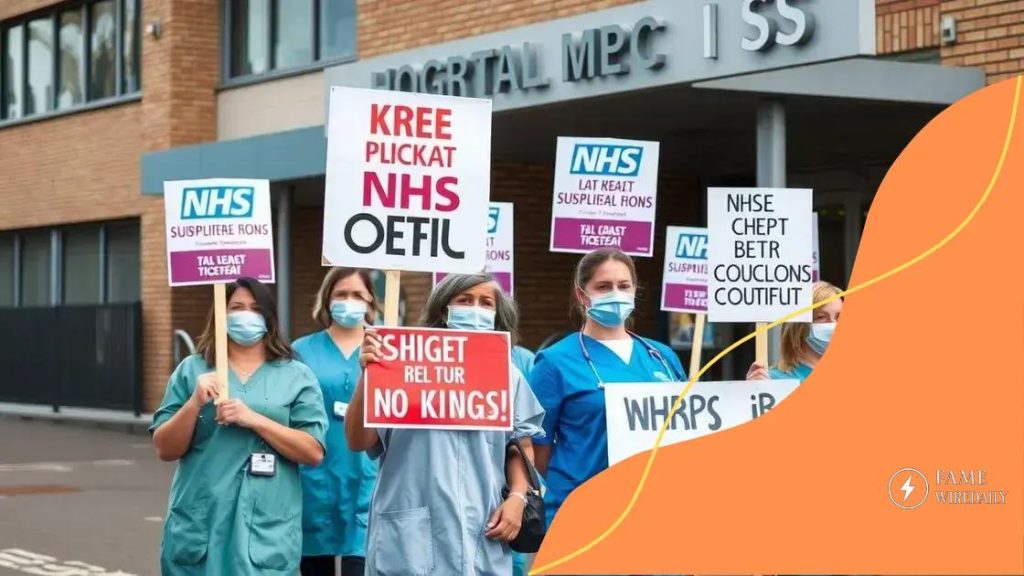NHS strikes: understanding the implications and impacts

Anúncios
The NHS strikes stem from low wages, staffing shortages, and demanding better working conditions, significantly affecting patient care and healthcare services across the UK.
NHS strikes have become a significant topic in recent months, raising questions about the future of healthcare in the UK. As healthcare workers voice their concerns, it’s crucial to understand the implications for both patients and the healthcare system. What does this mean for you?
Anúncios
Background of NHS strikes
The background of NHS strikes is essential to understand the current landscape of healthcare in the UK. Historically, the National Health Service (NHS) has faced numerous challenges, ranging from funding issues to staffing shortages. These challenges have paved the way for the recent wave of strikes, as healthcare professionals advocate for better conditions and pay.
Historical context
The NHS was established in 1948, aiming to provide healthcare for all, free at the point of use. Over the decades, however, economic pressures and political decisions have led to significant disparities in funding. Many workers now feel compelled to strike to address these inequalities.
Reasons behind the strikes
Several factors have sparked the recent strikes:
Anúncios
- Low wages compared to inflation.
- Increased workload due to staff shortages.
- Concerns about patient safety and care quality.
As striking NHS workers aim to improve their work conditions, their actions underline the urgency of these issues. Staff burnout and frustration have reached critical levels, with many fearing that the care provided to patients is at risk.
Public support for the strikes has fluctuated, but many recognize that improving conditions for healthcare workers is synonymous with ensuring better care for patients. Understanding the NHS strikes requires an exploration of these interconnected factors, as they highlight not just professional grievances but also the overall health service’s ability to function effectively.
Key events leading to current strikes
Understanding the key events leading to current strikes involves looking at a timeline of significant incidents that have shaped the NHS landscape. Over recent years, several critical occurrences have resulted in heightened tensions among healthcare workers, prompting strikes across the UK.
Pay disputes
One of the main catalysts for the strikes has been ongoing discussions about fair compensation. Many NHS workers feel that their wages have not kept pace with inflation and rising living costs. This growing frustration has led to renewed calls for better pay.
Staff shortages
Staff shortages in the NHS have worsened due to various factors, including increased retirements and burnout from demanding workloads. As more healthcare professionals leave their jobs, the remaining staff face higher demands, creating a cycle of discontent. This situation has made strikes seem like the only effective way to bring attention to the issue.
Government policies
Changes in government policies have also played a critical role. Cuts to budgets and modifications in health funding have created uncertainty and mistrust among workers. Many believe these policies undermine patient care and worker conditions, leading to coordinated action. Additionally, when recent measures aimed at financial efficiency are perceived as impacting care quality, frustration grows.
- Reports of high stress levels among healthcare professionals.
- Calls from unions advocating for fair treatment.
- Public debates regarding funding priorities in healthcare.
The combination of these key events signifies a turning point, where healthcare professionals feel they must take action. As these issues continue to unfold, the implications may greatly influence the future direction of healthcare in the UK.
Impact on patients and healthcare services

The impact on patients and healthcare services due to NHS strikes is profound and multi-faceted. As healthcare professionals participate in strikes, it affects not just their working conditions but also the quality and availability of care for patients.
Delays in treatment
One of the most immediate effects of strikes is the delay in treatment for patients. Scheduled surgeries and appointments may be postponed or canceled altogether, leading to longer waiting times. This situation can especially be tough for patients with urgent health needs, as their conditions may worsen during these delays.
Increased pressure on remaining staff
When NHS workers strike, those who continue to work face increased pressure. This often leads to burnout, as the remaining staff must cover the duties of their striking colleagues. The pressure can diminish the quality of patient care, making it challenging for healthcare professionals to meet the needs of all patients effectively.
- Healthcare professionals are stretched thin, affecting service delivery.
- Patients may experience increased anxiety due to uncertainty about their care.
- The quality of healthcare services may decline if staff morale drops.
This cycle of stress and dissatisfaction may lead to further healthcare workers leaving the profession, exacerbating the very issues that triggered the strikes. Over time, these impacts can create a ripple effect, further straining the NHS as a whole.
Public perception of the NHS can also change as strikes unfold. While many understand the need for better conditions for workers, others may feel frustrated by the disruptions in their care. Navigating this balance becomes crucial for the NHS as it seeks to reform itself while maintaining trust within the public.
Public response and media coverage
The public response and media coverage surrounding NHS strikes play a crucial role in shaping opinions and attitudes toward the healthcare system. When these strikes occur, they often attract significant media attention, which can influence public perception.
Media portrayal
The media coverage of NHS strikes varies widely. Some outlets highlight the struggles of healthcare workers, portraying them as heroes fighting for basic rights and better working conditions. Others may focus on the disruptions and challenges faced by patients, emphasizing the negative impacts of the strikes.
Public opinion
Public response can be mixed. Many people empathize with the goals of the striking workers, recognizing the importance of fair pay and safe working conditions. However, this sympathy can be tempered by concern over delays in treatments and services.
- Polling often shows that a majority of the public supports healthcare workers’ rights to strike.
- Conversely, some segments of the population express frustration over missed appointments.
- Social media plays a significant role in shaping public sentiment, as individuals voice their support or criticism rapidly.
This dynamic creates an evolving dialogue between the public and the NHS. Strikes challenge the public to consider the deeper issues at play, including underfunding and the future of healthcare delivery.Media coverage helps amplify these issues, leading to broader discussions about the state of the NHS and potential reforms. As strikes continue, both media narratives and public response will likely evolve, reflecting the complexities of the healthcare environment.
Future outlook for the NHS
The future outlook for the NHS is filled with both challenges and opportunities. As the healthcare system adapts to ongoing strikes and increasing public scrutiny, the direction it takes will significantly affect patients and staff alike.
Adapting to changes
One major aspect of the NHS’s future is its ability to adapt to changing demands. This includes addressing the workforce shortages that have been exacerbated by strikes. Retaining and attracting healthcare workers will be crucial in ensuring that the system can meet patient needs effectively.
Policy reforms
Another key factor in shaping the future will be government policy reforms. Policymakers are under pressure to invest more in the NHS and improve worker conditions. Success in this area could lead to a healthier, more sustainable system.
- New initiatives may focus on mental health support for workers.
- Increased funding might be targeted toward technology and infrastructure improvements.
- Policies promoting work-life balance could encourage staff retention.
As the NHS evolves, patient care will also need to be prioritized amid these changes. With innovations in technology and treatment, there is potential for improved outcomes. Telehealth and digital solutions could enhance access to care, especially in underserved areas.
The relationship between the public and the NHS may also change in the coming years. As awareness of healthcare challenges grows, public engagement in advocacy and policy changes could strengthen the system overall. The ability of the NHS to respond and innovate in the face of these pressures will be critical to its success moving forward.
FAQ – Frequently Asked Questions about NHS Strikes
What are the main reasons for the recent NHS strikes?
The recent NHS strikes are primarily due to low wages, staffing shortages, and concerns about working conditions.
How do NHS strikes affect patient care?
NHS strikes can lead to delays in treatment and appointments, impacting the quality of care that patients receive.
What role does public opinion play in NHS strikes?
Public opinion can influence the outcome of strikes, as support for healthcare workers often prompts discussions on the need for reforms.
What changes are expected for the NHS in the future?
In the future, the NHS may focus on policy reforms, improving staff conditions, and integrating new technologies to enhance patient care.





